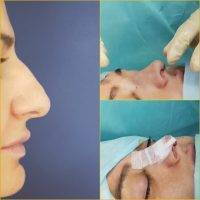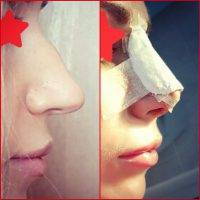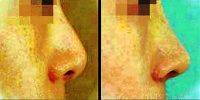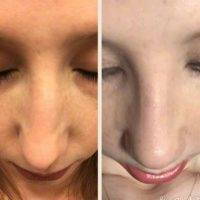Does A Nose Job Hurt?
There are many opinions on this matter: some people can endure discomfort and pain for the sake of the future beauty, for other very heavy to put up with discomfort, swelling and bruising. Many people are afraid of blood. Once the person comes back to normal, some patients say that the puffiness and swelling disappear very quickly, others notice it quite a long time.
Unpleasant consequences of surgery lasts approximately a year. Therefore, the end result of this work can be seen only after 10-12 months.
Does a nose job hurt?
Rhinoplasty is a surgical procedure absolutely painless for the patient, as performed under general anesthesia. Sensitivity returns in just a few hours after the end of anesthesia.
Each patient has own a pain threshold, so the sensations are different. In addition, a major role here is played by the complexity of the plastic surgery for nose.
For someone is just causes a feeling of discomfort. Some suffer from severe pain. But in almost all patients after the procedure is easy to chill as well, there is a slight increase in body temperature up to 37.5 degrees. This effect can last for 2-3 days after rhinoplasty.
On the day of the operation, as well as the next day after a rhinoplasty from the nostrils is leaking liquid of scarlet color, and gauze bandage gets wet of blood on the tip of the nose.
Cotton or gauze pads enhance the feeling of pain, as well as raspiranie of the nostrils by edema aggravates pain and worsens breathing.
Tampons help stop the bleeding, so without them in any way. If recovery occurs in the normal mode, tampons are removed the next day after nose reshaping. At 2-3 days often appears tickle in the throat when swallowing.
To eliminate them you need to rinse the throat furatsilinom. Constant dryness of the mouth caused by a violation of nasal breathing due to swelling. This period lasts for about 2 weeks.
Often, during recovery after rhinoplasty is observed eyelid edema, bruising caused by subcutaneous hemorrhages. The maximum degree of swelling can occur on day 2 after nose reshape surgery. It is has individual character, and not in any way affect the final result. Every day, the swelling will decrease and it will be completely unnoticeable after about a week.
The bandaging is most often accompanied by a slight soreness in the postoperative period, that has more to do with the psychological experiences. It is only closed rhinoplasty eliminates the need for bandaging, and this is its advantage.
During of such a procedure incisions are made inside the nose, which reduces the risk of bleeding.
If you have to work with the nasal septum and cartilage, the surgeon imposes the fixing sutures in the process of nose plastic surgery.
This ensures proper coalescence of tissues. Minus only in that it greatly complicates breathing.
Only after the removal of sutures, in about a week, unpleasant feelings completely disappear. Heavy bleeding, bruising, and a high degree of swelling is a signal that an urgent need to go to the doctor.
This phenomenon is not considered normal during recovery.
To reduce the pain and discomfort after rhinoplasty, psychologists are advised to treat yourself, to do something enjoyable and not overwork.
In the normal state of health you can safely go to the movies or just to the store. Do not withdraw into themselves.
Myth: Rhinoplasty is painful.
Quite a common myth that rhinoplasty is a painful procedure. If we compare this operation, for example, breast augmentation or abdominoplasty, it can be said that it not painful. In addition, with the presence of modern methods of anesthesia, this question can be considered irrelevant.
The nose operation is carried out in a state of sleep medication, and the patient does not feel anything.
Postoperatively, patients are more concerned tampons in the nasal cavity, which are removed on the day after nose beauty surgery and swelling around the eyes disappear within 2 weeks. Rhinoplasty is not painful.
Rhinoplasty: Do I get hurt?
The complexity of any plastic surgery depends on the wishes of the client, as well as the surgical methods of procedure. Rhinoplasty is only at first glance it seems a simple procedure, but it depends on the depth of the changes. It may involve the correction of skin, cartilages, bones, or all at once.If the slight change of the nose contour by using fillers can take place under local anesthesia, the complex correction may take several hours. Because plastic surgeons use three types of anesthesia for rhinoplasty:
1. Local anesthesia. The patient is conscious, but loses the sensitivity of the area, on which an anesthetic affects.The drug relieves pain, but the feeling of manipulation and touch remains. The anesthetic is injected directly into the tissue of the nose.
Local anesthesia with sedation is rarely used at the correction of the nose. The patient is able to moving into a state of light sleep.
However, plastic surgery of nose requires great precision, because the client’s sharp movements are undesirable.
The patient may have a vague recollection about the procedure after the sedation-like dreaming.
2. General anesthesia is used most often. It excludes the collision with the pain and allows the surgeon if necessary extend the anesthesia during rhinoplasty. The patient does not remember anything: no feelings or visual images.The anesthetic is injected intravenously, most likely with a dropper. Intubation is the companion of a general anesthetic. It involves introducing a thin tube into the trachea for air supply.
The tube also protects the airways from the blood, which can cause pneumonia. If the nose beaty surgery is performed without intubation, the respiratory tract is more at risk, as in the case of sedation. Rhinoplasty is held safely under endotracheal anesthesia.
Local anesthesia is the most desirable option for the patient, because the passes without any consequences. However, general anesthesia with intubation is most preferred for rhinoplasty.
Any medication can cause side effects, and anesthesia is no exception. Nausea, headache, sore throat, dizziness, tremors, muscle sensitivity are with which the patient may experience after anesthesia. However, rhinoplasty lasts an hour and a half and sometimes up to three hours because anesthesia is necessary in any case.An experienced surgeon, taking into account all the nuances that make the right choice in favor of one or sometimes the type of anesthesia.
Recovery after rhinoplasty.
Most often, patients are concerned that the face be blue-green in color and that will have to endure severe pain. Yes, without the bruising and pain will not manage. In most cases, the appearance becomes normal within a week. However, keep in mind that all the post-operative changes, such as swelling or changes in the shape are retained for about a year.
Go through the pain.
After the end effect of anesthesia, the patient begins to feel pain. But the next day the pain weakens substantially. In most cases, the post-operative discomfort can be reduced with the help of painkillers and applying ice. A week or two after the surgery the nose will react badly to touch.Rhinoplasty brings discomfort when in the nasal passages are investing tampons. If the surgeon uses the dressing to reduce edema and postoperative bleeding, the patient experiences pain and discomfort till removal of tampons.
Postoperative pain is reduced by about 80% when the bandaging material is not used.
Surgeons who do not use the dressings, all the incisions are sewn inside the nose, reducing the possibility of bleeding to zero. Both methods are often used.
If the nasal septum was leveled during surgery, the sutures are applied to the nasal septum, to hold the it in a flat position during the entire recovery process. The seam lightly hinders for free breathing, but sutures are removed within a week, and breathing becomes easier. Be engaged in that not annoying.Evaluating the results.
Recovery after rhinoplasty is time consuming. 80% of the swelling dissipates within the first thirty days, but the remaining 20% may last from six months to a year or even longer. You must have patience.
If you find that new nose does not correspond to desired, re-correcting procedure is carried out. However, such an operation can be performed at least after six months, and even up to a year after primary nose surgery. Swelling and bruising is normal for rhinoplasty, but excessive swelling and very pronounced hematoma is it is not normal. Ongoing bleeding is not also normal.
If something is wrong, call your doctor.









